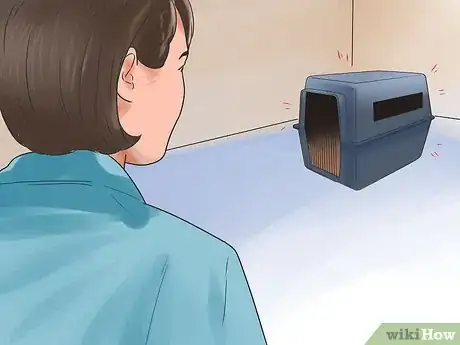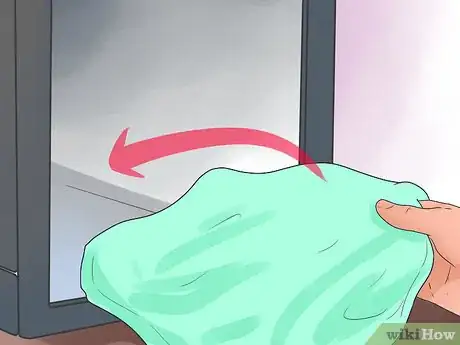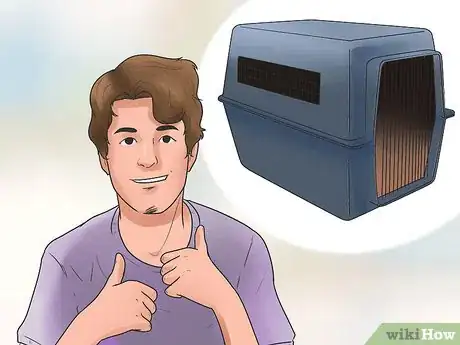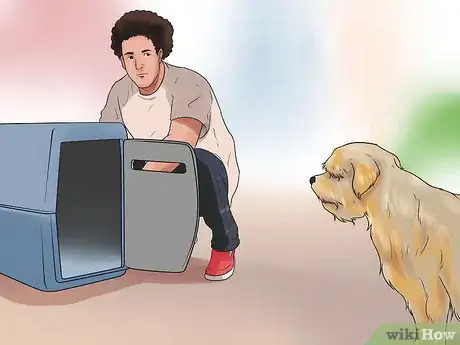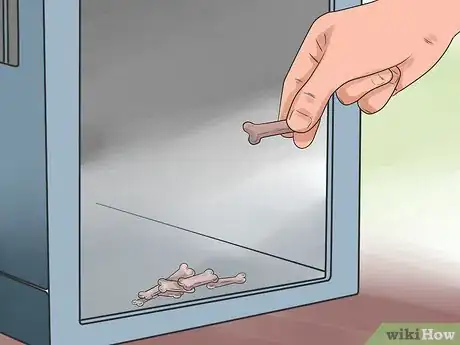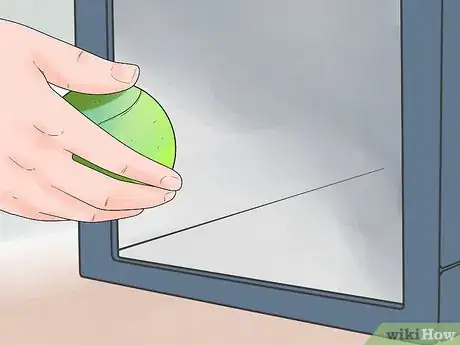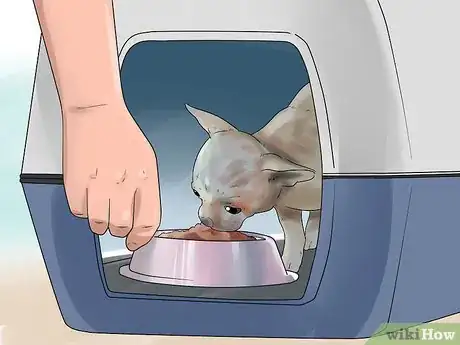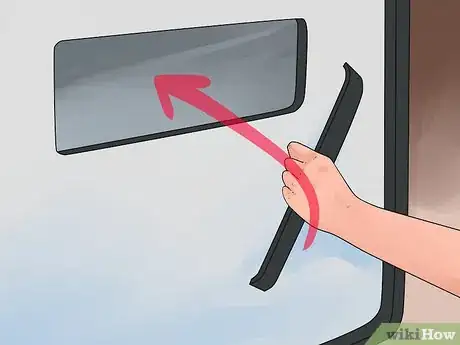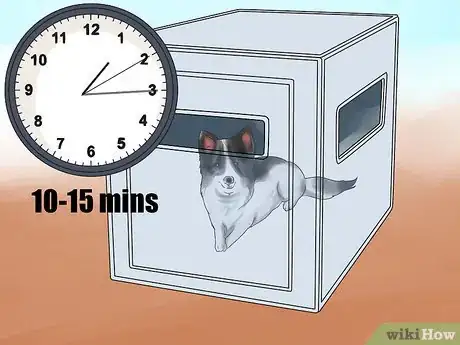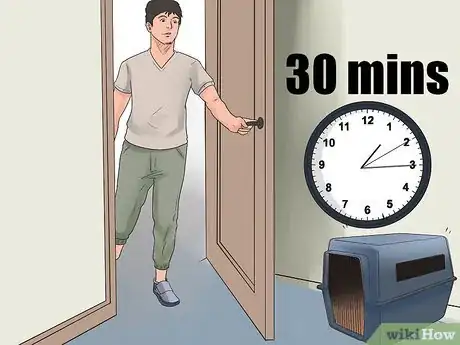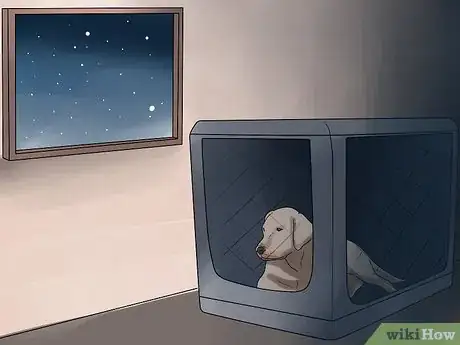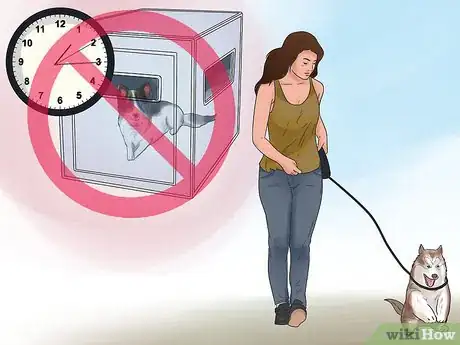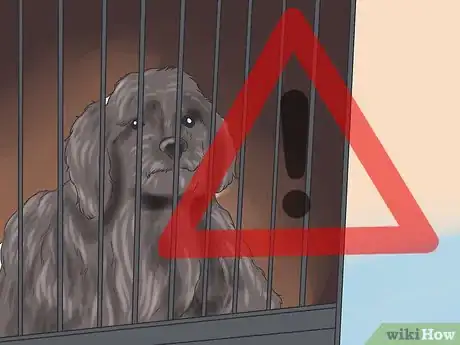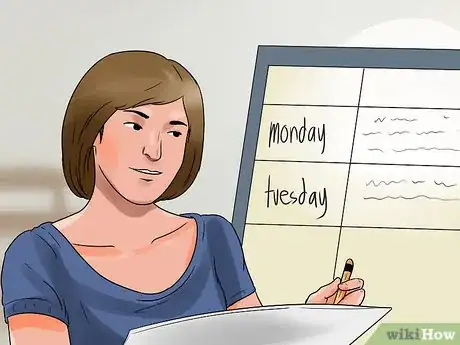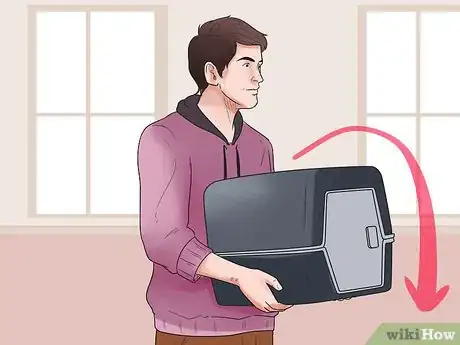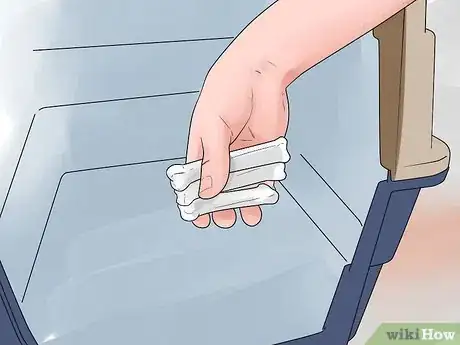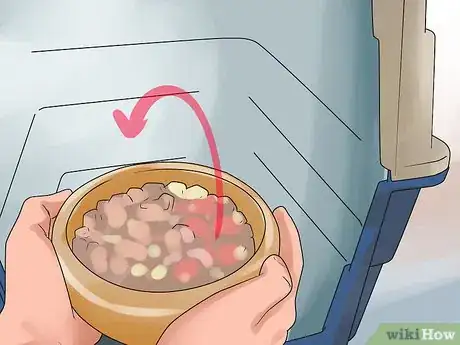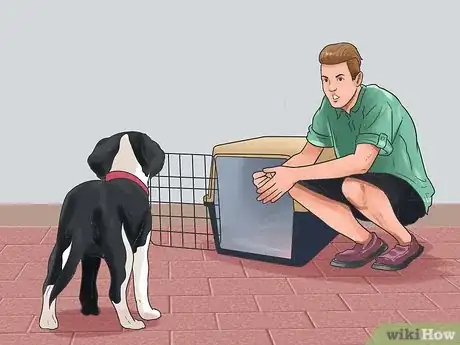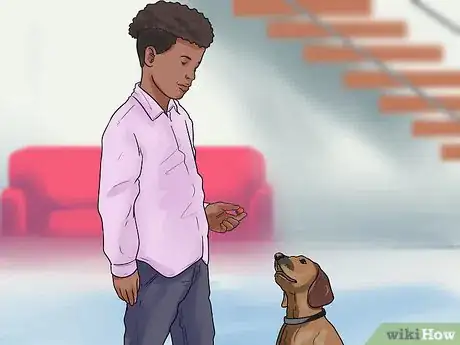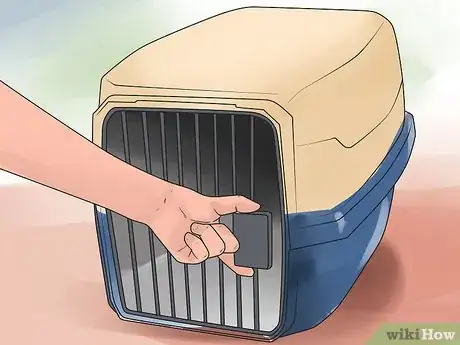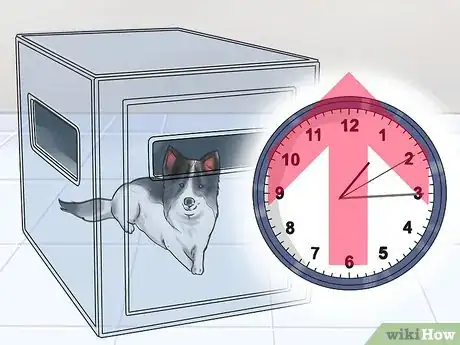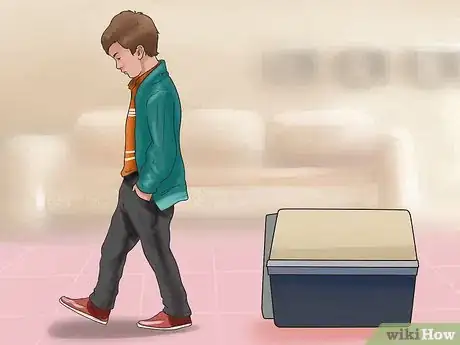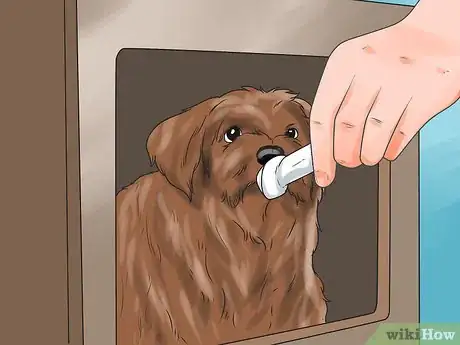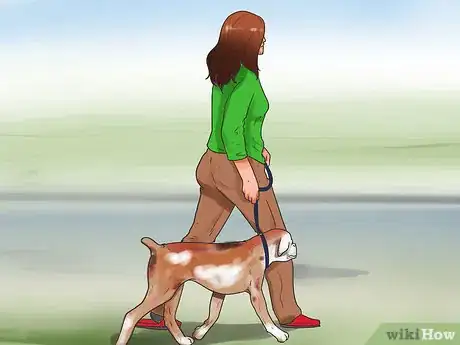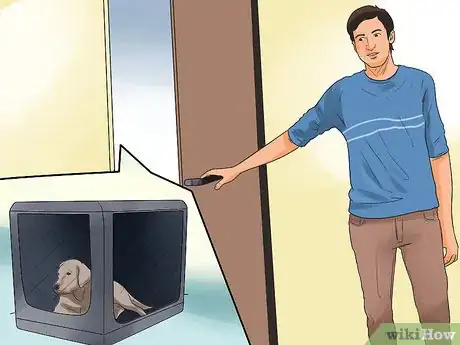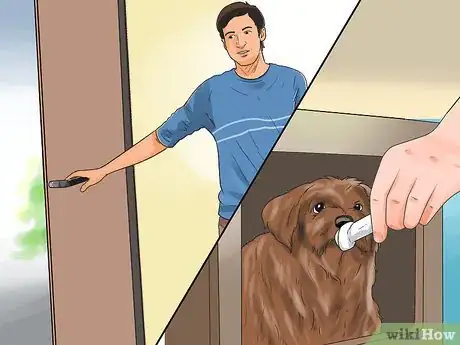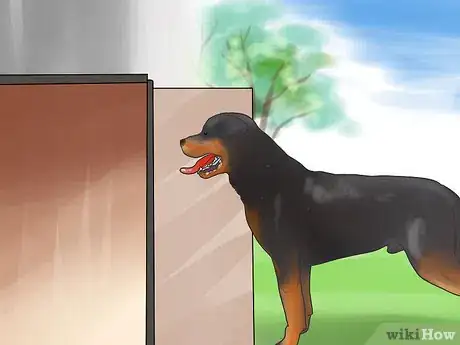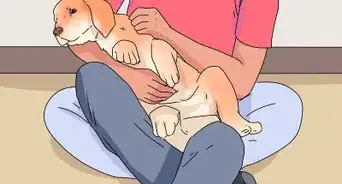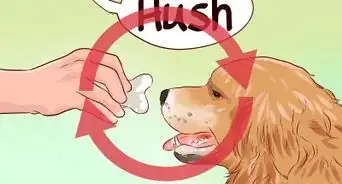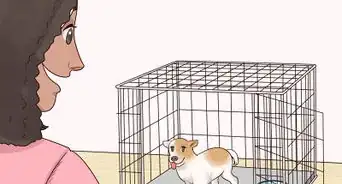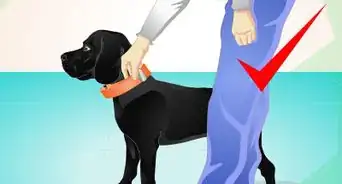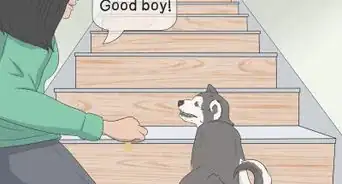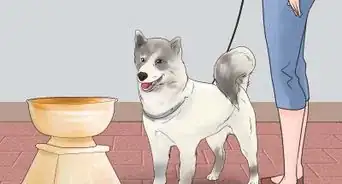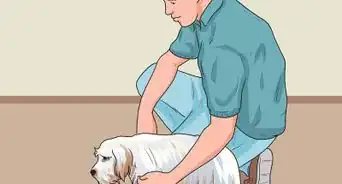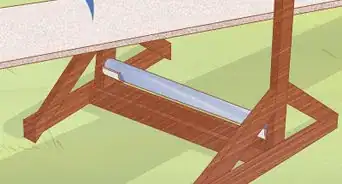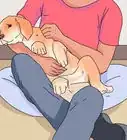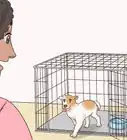This article was co-authored by Rendy Schuchat. Rendy Schuchat is a Certified Professional Dog Trainer and the Owner of the largest dog training facility, Anything Is Pawzible, based in Chicago, Illinois. With over 20 years of experience, Rendy specializes in positive dog training and behavior modification to help people build and strengthen their relationships with their dogs. She holds a BA in Psychology and Communications from the University of Iowa, an MA in Psychology from Roosevelt University, and a Certification in Dog Obedience Instruction from Animal Behavior Training and Associates. Rendy was voted one of the Best/Favorite Dog Trainers in Chicago by Chicagoland Tails Reader’s Choice Awards multiple times and was voted Chicago Magazine’s “Best Dog Whisperer” in 2015.
There are 11 references cited in this article, which can be found at the bottom of the page.
wikiHow marks an article as reader-approved once it receives enough positive feedback. In this case, 100% of readers who voted found the article helpful, earning it our reader-approved status.
This article has been viewed 279,855 times.
Crate training your puppy or adult dog is beneficial for both you and your dog. Some novices to crate training are concerned that crates are confining and unnatural. However, small, enclosed spaces are reminiscent of dens in the wild, and so are often comforting and natural for dogs. If you introduce your dog or puppy to the crate gradually and with lots of positive reinforcement, the crate will soon become a safe space that your dog enjoys resting in.[1] [2] You can either train your dog or puppy to love the crate slowly, over several days or even weeks, or in just a weekend, depending on what works best for your dog and your schedule. Adult dogs may take a bit longer to crate train than puppies, but be patient and your dog will learn to love the crate in no time.[3]
Steps
Preparing the Crate
-
1Find a good spot for the crate. When you begin crate training, it is best to put the crate in a place where you and your family spend a lot of time during the day, like the kitchen or living room. Dogs are social animals, and like to feel that they are part of the pack. It is important not to put the crate in an isolated location, like the basement or garage. The crate should never feel like an isolating punishment for your dog.[4]
- You should plan to move the crate to your bedroom at night when training a puppy, so you can take the puppy out when it needs to go to the bathroom.
- Some dog owners simply set up two crates, one in the living area of their homes, and one in the bedroom.
-
2Make the crate comfortable for your dog. Place a blanket or towel on the bottom of the crate for the dog to sleep on. If you are using a mesh or wire crate, you can also drape a breathable blanket or towel over the top of the crate to create a cozier, more den-like atmosphere that may help your dog feel more secure.
- Some dogs and puppies might mistake the bedding for something to chew on, or as bathroom material. If this is the case, remove the bedding and clean the cage, and proceed without bedding. You can add it back in later as your dog matures.
- Avoid crowding the crate with too many things, such as pillows, treats, water, and toys. A crate is meant to be a relaxing space for your dog to wind down, and too much entertainment could get them worked up.[5]
Advertisement -
3Be enthusiastic about the crate.[6] As you set up the crate, your dog may come over to investigate it. Say positive things about the crate to show your enthusiasm for it, and allow your dog to explore. However, you should not try to force your dog into the crate or close the door right away if he goes inside. Getting used to the crate takes time and patience, and the more excited you seem about the crate, the more excited your dog will become.
Crate Training Gradually
-
1Open the door to the crate. Leave the door of the crate open and verbally encourage your dog to check it out. Your dog may go in to have a look see, or may not be so easily convinced. If your dog does enter the crate, be sure to give a lot of positive praise to let him know that you are pleased.
- Do not shut the door on the dog if he does enter; wait until the dog is secure being in the crate before you close the door.
-
2Put some treats inside the crate.[7] You can close the treats inside the crate for a few minutes to build your dog's interest, or let the dog get to them right away. It is OK if the dog just pokes its head in to get the treats at first. Gradually move the treats further and further back into the crate until the dog has to go completely inside to get them.
-
3Place a favorite toy inside the crate. If your dog is not responding well to treats, try placing a favorite toy, or a brand new and especially tempting chew toy inside the crate.
-
4Feed your dog meals in the crate. Once your dog will voluntarily enter the crate to retrieve a toy or treat, you can begin feeding him meals inside the crate. Put the food dish all the way back in the crate, and leave the door open while the dog eats his first meal or two in the crate.
-
5Begin closing the door. Once your dog seems content standing and eating in the crate, you can begin closing the door while he eats. Stay nearby where the dog can see you. At the first few feedings, open the door as soon as the dog is done eating. Then gradually leave the door shut for a few additional minutes after each feeding, until the dog is staying in the crate for 10 minutes at a time.[8]
-
6Get your dog used to longer stays in the crate. Once your dog is used to eating in the crate with the door closed, you can leave him in for longer periods of time. Call your dog to the crate and give him a treat. Then choose a command, such as "kennel up," point to the crate, and encourage him to enter. When he does, give him a treat and close a door. Stay near the crate for the first 5 to 10 minutes, then leave the room for a short time. Come back in the room, and let the dog out.
- Repeat this process a few times a day for several days, gradually increasing the time your dog spends in the crate.
-
7Crate the dog while you leave the house. When your dog can successfully stay in the crate for 30 minutes without whining or showing signs of distress, you can leave him in the crate while you leave the house for short outings. Make sure to exercise your dog before you leave, and put him in the crate. You may want to leave a toy or two with him. The simply put him in the crate as you have been doing and leave without any extra fuss.[9]
-
8Crate your dog at night. It is best to keep the crate in your bedroom initially, especially if you have a puppy that may need to pee during the night. As the dog gets used to sleeping in the crate overnight, you can move the crate to a different location if you prefer.[10]
-
9Do not keep your dog in the crate for too long. Dogs need exercise and social activity to remain physically and emotionally healthy, and over-crating can lead to problems. Be aware of the following crate-time guidelines, and avoid leaving any dog in a crate for over 5 hours at a time, except at night.[11]
- Age 9-10 weeks: 30-60 minutes.
- Age 11-14 weeks: 1-3 hours.
- Age 15-16 weeks, 3-4 hours.
- Age 17+ weeks: 4+ hours (but never more than 6!).
-
10Respond to whining appropriately. Do not let your dog out of the crate because of whining, unless you believe the animal needs to eliminate. Otherwise, you are rewarding the whining and encouraging the behavior in the future. Ignore your dog's whines for a few minutes. If he does not give up, take him outside quickly and matter-of-factly to eliminate, and then return the dog to the crate. Make sure you do not teach the dog that whining = escape from the crate.[12]
Crate Training Over a Weekend
-
1Make a schedule and train your dog over a weekend. Many people don't have time to spend weeks crate-training a dog. If you follow the prescribed steps here, and remain positive and patient with the dog, most animals can be conditioned to love the crate in a single weekend.[13]
-
2Get the crate ready ahead of time. Purchase your crate and place it in the desired location. You can do this a few days ahead of time to get the dog used to the crate's presence. Leave the door of the crate open so your dog can explore.
-
3Begin placing treats in the crate Friday night. Sneak a few treats into the crate on Friday evening, and replace them as your dog discovers them. You can continue to sneak treats into your dog's crate after the initial training period is over to help maintain the positive association with the crate.
-
4Serve Friday night dinner in the crate. Put your dog's evening meal in a bowl in the back of the crate. If your dog is reluctant to enter the crate completely, slide the bowl closer to the door, but as the dog begins to eat, try to push it further into the crate. If the dog seems comfortable, close the door until he is done eating, but only if things are going well.
-
5Begin active training on Saturday morning. For the first training session, sit down next to the crate and call your dog. Show the dog a treat, and give a command to enter the crate (for instance "go to bed" or "kennel up",) then toss the treat into the crate. When the dog goes into the crate to get the treat, give him enthusiastic praise, and another treat while he is inside. Give your dog another command (e.g. "come out" or "OK") to leave the crate, and then repeat.
- Repeat this process 10 times, then take a short break, and repeat another 10 times.
-
6Ask your dog to earn the treat. Later Saturday morning, do another session. Give the first few treats as before. After a few times, instead of just throwing the treat into the crate, give the command and don't give the treat until your dog has entered the crate. Then give the command to leave the crate and give your dog another treat when he comes out.
- Repeat this about 10 times, or until your dog appears to understand what is happening.
- Take a short break, and then do another 10 repetitions.
-
7Close the crate door on Saturday afternoon. Begin by sending the dog into the crate and giving him a treat a few times as before. After a few repetitions, send the dog into the crate, give him a treat, and then gently close the crate door. Feed the dog a few treats through the door, and then open it. Give your dog the command to come out, and repeat.
- Do the exercise 10 times, leaving the door open a little longer each time. Try to build up to 10, then 30 seconds.
- If your dog seems anxious, only close the door part way at first.
- Using lots of positive reinforcement throughout this process will minimize your dog's anxiety.
-
8Increase the time in the crate. Take a break, then repeat the above exercise. This time, once you close the crate door, sit down near the crate for increasingly long intervals of time, until the dog is comfortable being in the crate for a minute at the time.
-
9Accustom your dog to being in the crate alone. On Saturday evening, begin practicing leaving the dog alone in the crate for short periods. Begin with a few short stays in the crate as above. Next, send the dog into the crate, and then walk across the room or out of sight before coming back and rewarding your dog. Repeat this process 10 times. Then take a half hour break, and do it all again.
-
10Practice longer crate times on Sunday morning. Get a chew bone, or a KONG toy stuffed with food, and ask your dog to enter the crate. Then give him the toy, close the door, and then relax in the same room reading or watching TV for half an hour while the dog chews the toy. When the time is up, give your dog the command to come out and open the door and take away the toy. Repeat the process an hour or two later.
- It is best not to celebrate the dog coming out of the crate too much. You want the dog to be excited going into the crate, not coming out.
-
11Give your dog a good workout. For the next session, you will want your dog to be well-exercised and ready to rest. Take him out for a long walk or play session, and get him tired out.[14]
-
12Leave the room. Send your dog into the crate, and give him his special chew toy. Close the door and then leave the room for 10 minutes. Come back and let him out for awhile, then repeat the process with increasingly longer times in the crate. Make sure to give your dog play and bathroom breaks in between, and build up to an hour of crate time for your dog.
-
13Leave the house. On Sunday evening, it is time to try leaving the house. Send your dog into the crate and give him his chew toy. Then leave the house for 10 minutes. When your return, let the dog out of the crate and go about your evening. Do not celebrate or act excited about leaving or returning. You want to teach your dog that entering and exiting the crate is a totally normal event, and nothing to get excited about.[15]
-
14Head out on Monday morning. After the weekend crate training, your dog should be ready to stay in the crate for several hours at a time, depending on the dog's age. Exercise your dog thoroughly in the morning, and then send him to the crate and give him a chew toy. Be sure not to make a big fuss about leaving, and only stay gone for a few hours before returning to give your dog a midday break. Remember to follow the age guidelines below, and don't leave your dog in the crate for too long:[16]
- Age 9-10 weeks: 30-60 minutes.
- Age 11-14 weeks: 1-3 hours.
- Age 15-16 weeks, 3-4 hours.
- Age 17+ weeks: 4+ hours (but never more than 6 hours!).
Expert Q&A
-
QuestionHow do I know if my dog's crate is too small?
 Rendy SchuchatRendy Schuchat is a Certified Professional Dog Trainer and the Owner of the largest dog training facility, Anything Is Pawzible, based in Chicago, Illinois. With over 20 years of experience, Rendy specializes in positive dog training and behavior modification to help people build and strengthen their relationships with their dogs. She holds a BA in Psychology and Communications from the University of Iowa, an MA in Psychology from Roosevelt University, and a Certification in Dog Obedience Instruction from Animal Behavior Training and Associates. Rendy was voted one of the Best/Favorite Dog Trainers in Chicago by Chicagoland Tails Reader’s Choice Awards multiple times and was voted Chicago Magazine’s “Best Dog Whisperer” in 2015.
Rendy SchuchatRendy Schuchat is a Certified Professional Dog Trainer and the Owner of the largest dog training facility, Anything Is Pawzible, based in Chicago, Illinois. With over 20 years of experience, Rendy specializes in positive dog training and behavior modification to help people build and strengthen their relationships with their dogs. She holds a BA in Psychology and Communications from the University of Iowa, an MA in Psychology from Roosevelt University, and a Certification in Dog Obedience Instruction from Animal Behavior Training and Associates. Rendy was voted one of the Best/Favorite Dog Trainers in Chicago by Chicagoland Tails Reader’s Choice Awards multiple times and was voted Chicago Magazine’s “Best Dog Whisperer” in 2015.
Certified Professional Dog Trainer Your dog might not be able to sit up all the way or completely stretch out while lying down.
Your dog might not be able to sit up all the way or completely stretch out while lying down. -
QuestionWhat should you do if your dog won't go in their crate?
 Ty BrownTy Brown is a Dog Behaviorist and Trainer and the Owner of Ty the Dog Guy, a business that provides dog training through digital resources (podcasts, web series, and online courses) along with in-person dog training. Ty has over 17 years of experience in dog training and specializes in both mitigating unruly pet behavior and service dog training. Ty has been awarded the "Best of State Award" for dog training in Utah ten times and his work has been featured in ABC, NBC, CBS, Spike TV, and Entrepreneur Magazine.
Ty BrownTy Brown is a Dog Behaviorist and Trainer and the Owner of Ty the Dog Guy, a business that provides dog training through digital resources (podcasts, web series, and online courses) along with in-person dog training. Ty has over 17 years of experience in dog training and specializes in both mitigating unruly pet behavior and service dog training. Ty has been awarded the "Best of State Award" for dog training in Utah ten times and his work has been featured in ABC, NBC, CBS, Spike TV, and Entrepreneur Magazine.
Dog Trainer What you want to do is create a positive association around going into the crate. Try throwing a treat inside, letting the dog in to get the treat, and inviting them to come back out. Do this again and again and after a little while, shut the door for a second and then open the door. After a while, shut the door for a little bit longer. This can take some of the sting out of staying in a crate for longer, as it can help your dog realize they are comfortable and safe inside of a crate.
What you want to do is create a positive association around going into the crate. Try throwing a treat inside, letting the dog in to get the treat, and inviting them to come back out. Do this again and again and after a little while, shut the door for a second and then open the door. After a while, shut the door for a little bit longer. This can take some of the sting out of staying in a crate for longer, as it can help your dog realize they are comfortable and safe inside of a crate. -
QuestionCan I put a blanket in there for my dog?
 Pippa Elliott, MRCVSDr. Elliott, BVMS, MRCVS is a veterinarian with over 30 years of experience in veterinary surgery and companion animal practice. She graduated from the University of Glasgow in 1987 with a degree in veterinary medicine and surgery. She has worked at the same animal clinic in her hometown for over 20 years.
Pippa Elliott, MRCVSDr. Elliott, BVMS, MRCVS is a veterinarian with over 30 years of experience in veterinary surgery and companion animal practice. She graduated from the University of Glasgow in 1987 with a degree in veterinary medicine and surgery. She has worked at the same animal clinic in her hometown for over 20 years.
Veterinarian Absolutely. The idea is to make the crate a cozy, inviting place. Adding a cozy bed and a blanket is a great way to make it snuggly. Also put in a safe chew toy (that isn't a choking hazard when the dog is alone with it) and a favorite toy.
Absolutely. The idea is to make the crate a cozy, inviting place. Adding a cozy bed and a blanket is a great way to make it snuggly. Also put in a safe chew toy (that isn't a choking hazard when the dog is alone with it) and a favorite toy.
Warnings
- Do not use the crate as a form of punishment. You want the dog to love the crate, not fear it. Using the crate as a punishment will send the wrong message and teach the dog to hate the crate.⧼thumbs_response⧽
- Never leave a sick dog in a crate. If your dog is vomiting, has diarrhea, or a fever, do not leave it in a crate, and do take the animal to the vet right away.[18]⧼thumbs_response⧽
References
- ↑ Ty Brown. Dog Trainer. Expert Interview. 4 June 2020.
- ↑ Rendy Schuchat. Certified Professional Dog Trainer. Expert Interview. 26 January 2021.
- ↑ http://bestfriends.org/dog-crate-training.aspx
- ↑ http://www.animalhumanesociety.org/training/crate-training-your-puppy
- ↑ Ty Brown. Dog Trainer. Expert Interview. 4 June 2020.
- ↑ Ty Brown. Dog Trainer. Expert Interview. 4 June 2020.
- ↑ Ty Brown. Dog Trainer. Expert Interview. 4 June 2020.
- ↑ http://www.brown.edu/Research/Colwill_Lab/CBP/Crate.htm
- ↑ http://www.brown.edu/Research/Colwill_Lab/CBP/Crate.htm
- ↑ http://www.humanesociety.org/animals/dogs/tips/crate_training.html
- ↑ http://www.humanesociety.org/animals/dogs/tips/crate_training.html
- ↑ http://www.humanesociety.org/animals/dogs/tips/crate_training.html
- ↑ http://www.aspca.org/pet-care/virtual-pet-behaviorist/dog-behavior/weekend-crate-training
- ↑ Ty Brown. Dog Trainer. Expert Interview. 4 June 2020.
- ↑ http://www.aspca.org/pet-care/virtual-pet-behaviorist/dog-behavior/weekend-crate-training
- ↑ http://www.humanesociety.org/animals/dogs/tips/crate_training.html
- ↑ :http://www.humanesociety.org/animals/dogs/tips/crate_training.html
- ↑ http://inch.com/~dogs/cratetraining.html
About This Article
To teach your dog to love its crate, start by putting the crate in an area where your family spends a lot of time, so your dog doesn’t feel isolated. You can also make the crate comfortable by lining it with something soft, like a towel or blanket. Then, leave the door of the crate open and place treats or toys inside so your dog will want to go in and investigate. Additionally, feed your dog meals in the crate so it associates it with positive experiences. Once your dog is comfortable, shut the door for brief periods before gradually lengthening the time it spends inside. For advice from our Veterinary co-author on how to crate train your dog over a weekend, read on!


